Hawaiian Coffee Bean Story how Hawaiian kona coffee beans make Kona coffee flavor characteristics
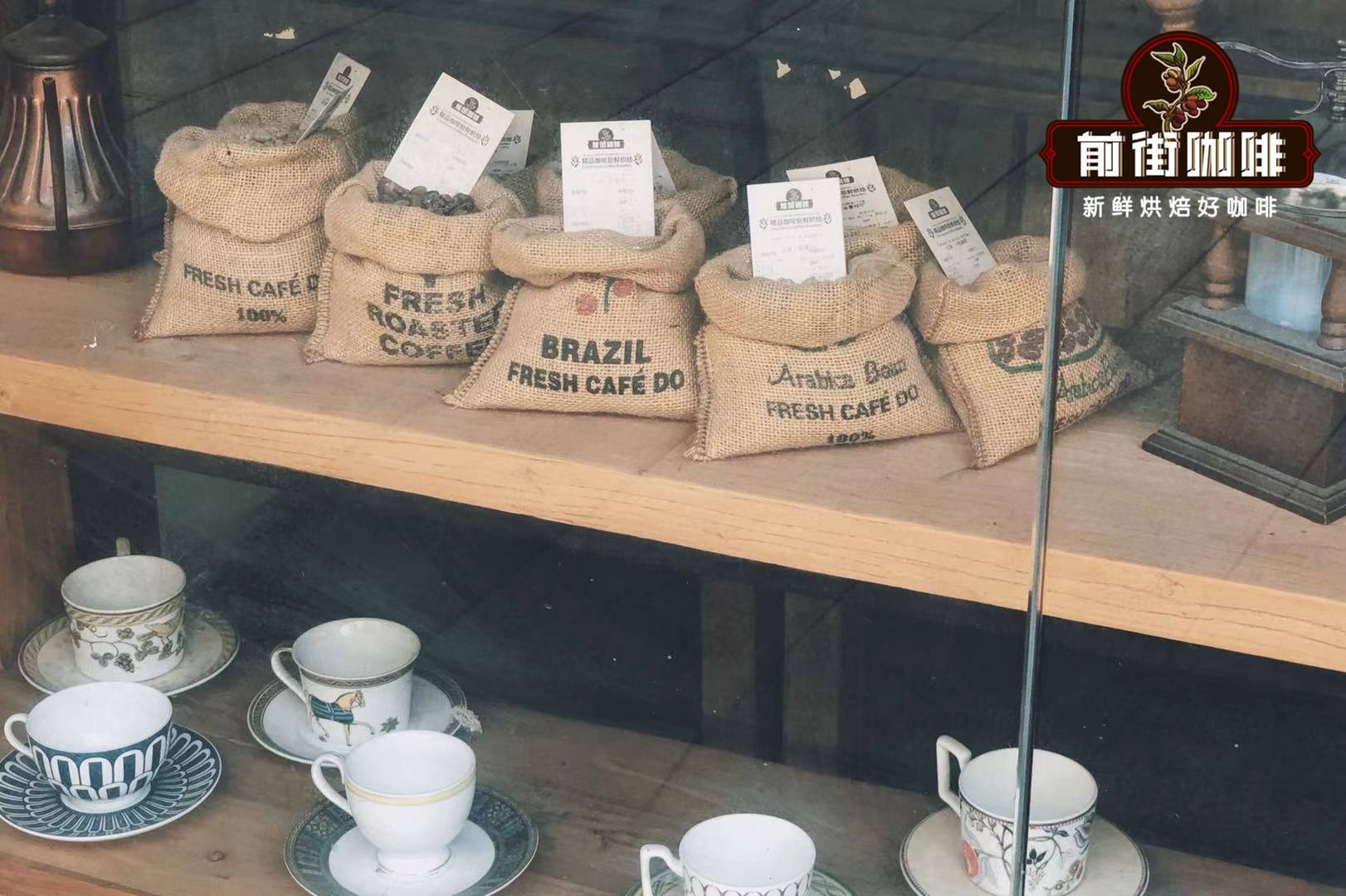
Professional coffee knowledge exchange more coffee bean information please follow the coffee workshop (Wechat official account cafe_style)
Strong, mellow coffee can be produced because the firerock soil on the west coast of Hawaii provides dense nutrients for coffee trees. With an annual output of more than 8 million pounds, Hawaii is the only state in the United States that grows coffee. Hawaiian coffee is smooth and fragrant, with attractive nutty flavors and well-balanced acidity. As for the description of the taste of coffee, Qianjie Coffee believes that everyone will have their own interpretation, and what Qianjie Coffee really wants to do is to guide friends who are new to boutique coffee to find a connection between coffee and taste buds.
Hawaiian coffee
Twenty years after the independence of the United States, the coffee industry at that time was mainly commercial coffee. Europe made a lot of money, and the United States also wanted a share of the coffee. But the United States was not suitable for growing coffee, and the incorporation of Hawaii solved the problem by introducing iron pickups from Guatemala and planting them in an all-round way. At that time, Jamaica's Blue Mountain Coffee had been developed for 60 years, and it was very mature. Hawaii, which is also an island, was hard not to emulate. So we often see a comparison between the Blue Mountain Coffee of Jamaica and the Kona Coffee of Hawaii.
Hawaii is an affiliated archipelago of the United States, located in the middle of the Pacific Ocean. Among the many islands, only the big island grows coffee, not only because the elevation of the big island is higher than that of other islands, but also because the climate is the most suitable, and there are not too many hybrid varieties, ensuring the purity of the planting environment.
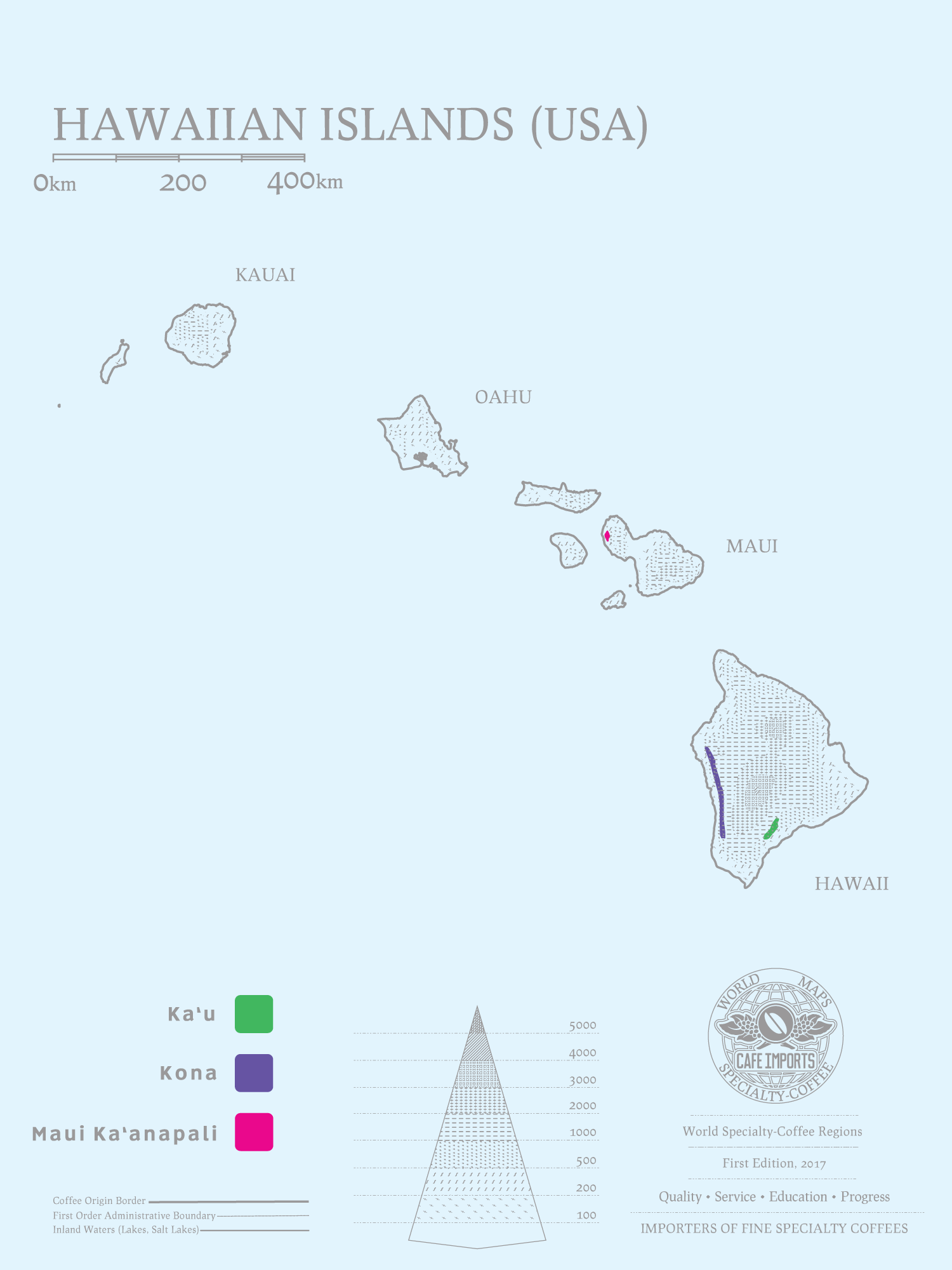
Although the elevation of the Big Island is the highest than that of other islands, the elevation of the coffee growing area is only 300,000m. It is often said that the elevation requirements in the field of boutique coffee are not up to standard, but no one will say that Kona coffee does not belong to boutique coffee. Haha. We in front street coffee often discuss with other coffee counterparts, for the concept of boutique coffee, there seems to be a certain standard, but there are always a few chic coffee will break this standard, this is what Qianjie coffee thinks coffee is interesting.
Although Kona Coffee on the Big Island is still the most famous, coffee is currently grown on each of the major islands on more than 950 farms, with a harvest area of more than 7900 acres. Hawaii's year-round warm, sunny weather, rich volcanic soil, continuous hillsides, quiet trade wind and abundant Rain Water combination are the main factors that make Hawaiian coffee the best coffee in the world.
In 1813, the first plants were brought to Oahu, although sugar as an agricultural product for farmers far exceeded coffee. In the late 1820s, the bourbon variety of coffee was brought to the Big Island, and the first coffee-focused estates were established over the next decade.
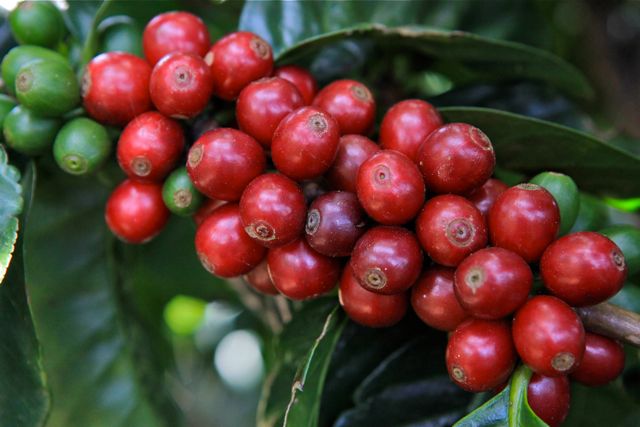
However, the development of the coffee industry here is not smooth. For example, in 1858, coffee production on the island of Kauai was halted by Fusarium wilt. Then there was competition in the sugar industry, with landowners switching from coffee to sugar to increase income. These factors led to the abandonment of many plantations and subsequent division into smaller farms. The United States began to occupy the islands in 1898 and removed protective tariffs on coffee, further weakening the market. As a result, more farmers began to plant sugar cane. It wasn't until the 1980s that the coffee industry took a turn for the better because of falling sugar prices.
There are currently 12 coffee areas spread throughout the island, of which Kona is the most famous. However, due to low production and high production costs, with the increasing demand for boutique coffee in recent years, the price of Kona on the market is catching up with the Blue Mountain of Jamaica, and it is becoming more and more difficult to buy good Kona beans. Although the price of Hawaiian coffee is often high, traceability is high.
Kona coffee grading system
Kona coffee beans are actually subdivided into five levels, and the first three levels are more common, followed by Extrafancy, Fancy, No.1, Primary and Peaberry (round beans, commonly known as male beans, because some coffee lovers love, especially pick out higher prices, about 5% of Kona coffee beans are Peaberry). Except for the special selection by Peaberry, the other four grades are graded according to bean grain size, weight and defect ratio.
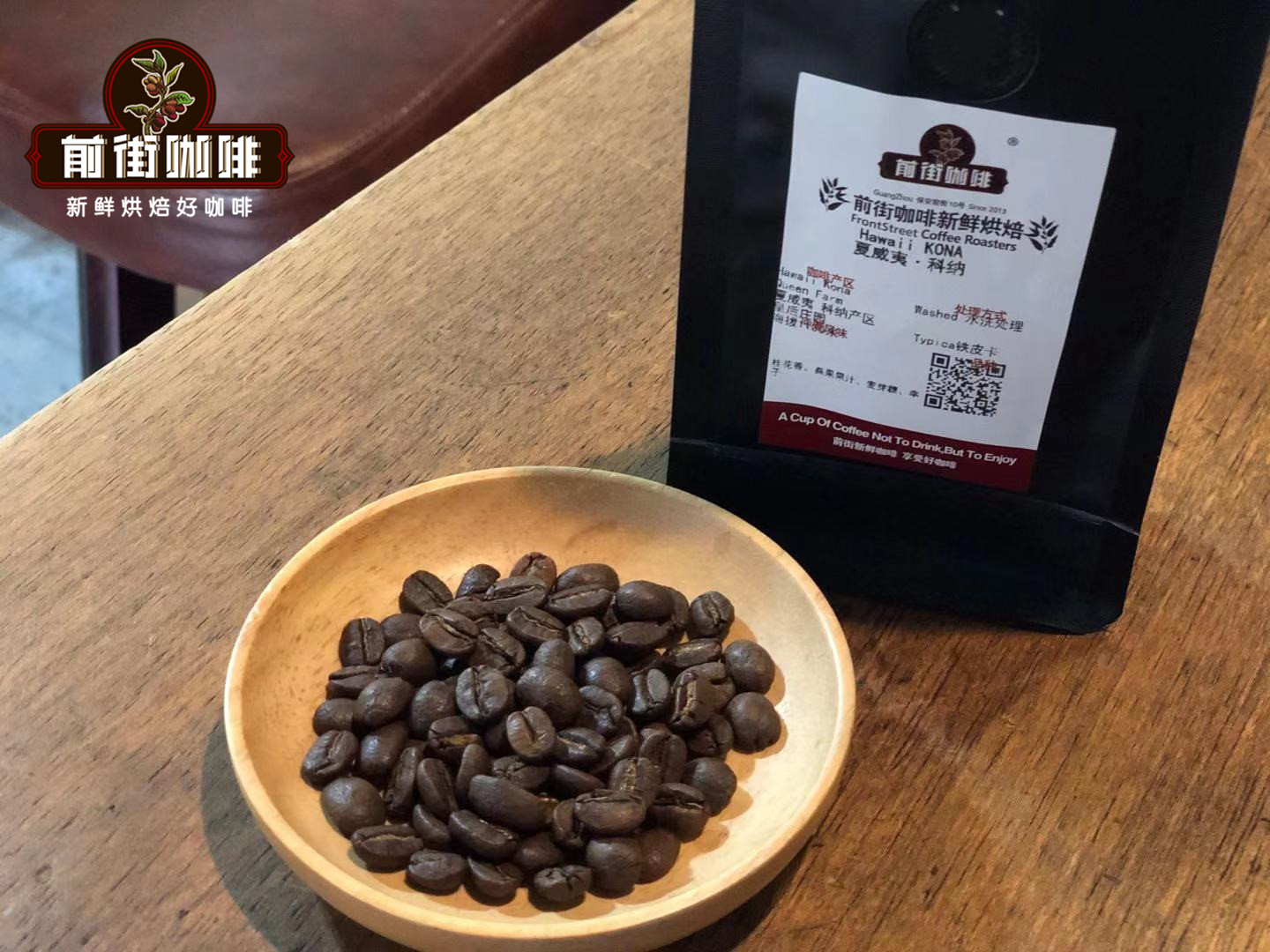
The finest Kona has a mild acidity with a hint of wine, a very rich palate and an irresistible aroma.
Kona coffee
Kona raw coffee beans are labeled with a number on the sack before they are exported, indicating that they have been certified by the Hawaiian Department of Agriculture and bear an official seal, so they are more expensive. The price of Kona coffee is second only to Blue Mountain coffee on the market. And Kona coffee from sowing, picking to receive washing treatment, sun and polishing, all rely on manual completion, so the annual output is limited. At present, Hawaiian 100%Kona Coffee and Blue Mountain Coffee are synonymous with premium coffee.
The unique natural environment of Kona region gives birth to Arabica coffee, which promotes it to become the plantation with the highest coffee production in the world. Not only the quality is guaranteed, but also the coffee cultivated under the unique growth environment and climate is more fragrant. The coffee beans planted in Kona area are very good-looking, full in shape and bright in color, and are known as "the most beautiful coffee beans in the world".
Most of the coffee trees in the Kona region grow on volcanoes and can absorb a lot of nutrients in the soil, coupled with artificial cultivation technology, so that every coffee bean here has a different appearance. The Kona coffee made from the grinding of this kind of coffee beans is silky, full-bodied, slightly nutty and moderately acidity, just like the colorful scenery on the island of Hawaii.
Kona coffee has always been grown at home. The harvest season of Kona coffee is from late August to January of the following year, when farmers pick the ripe fruit in batches and get coffee beans after processing. At first, only men were allowed to work in the coffee garden, and later women joined in. This kind of family production of Hawaiians preferred to rely on the efforts of their families rather than hiring workers to work, so it was normal for Hawaiians to have eight or nine children at that time. Since then, new immigrants from the Philippines, the United States and Europe have come to Hawaii to engage in the coffee industry. Over time, Hawaii has formed a social atmosphere that centers on family culture and is easy to absorb foreign cultures. and make it a major feature of Hawaii.
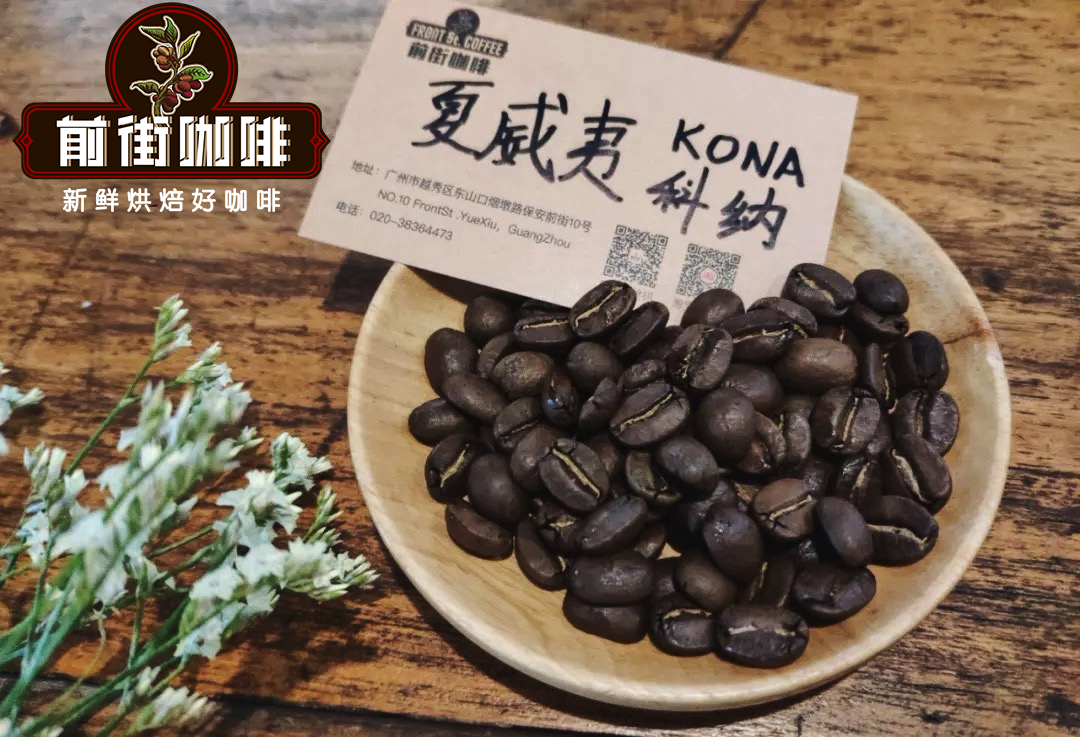
Queen's Manor
Kona of Front Street Coffee comes from Queen Queen Farm Farm. In 2009, he won the runner-up title in the 2011 Geberia (Hawaii KONA Review) Cup Grand Prix. 70% of the harvest there is the top premium boutique beans, and it is a farm known for its high quality. Even the slightly inferior boutique beans have the aroma of super boutique beans, which people in the baking industry are amazed and full of praise.
At present, the common Hawaiian coffee on the market, in addition to the kona district of the Big Island, including Maui, Cafu Island, and lovely Island, all have coffee estates on display. The common Hawaiian coffee includes different varieties such as Typica, Mocca and Catuai.
Kona, Hawaii
Producing area: Kona producing area
Manor: Queen's Manor
Altitude: 1100m
Variety: iron pickup
Treatment: washing
Baking suggestion
Kona and Blue Mountain Coffee are low-density beans, the temperature of the beans should not be too high, when sending out sweet taste, the color changes to light yellow, high moisture content, and needs to be steamed for enough time. Coffee beans are fresh and clean and have a strong and heavy touch. Kona should not roast too deeply. Qianjie coffee is recommended for light roasting.
Machine: Yang family 800N, raw bean 550g
Input bean temperature: 200℃
Yellowing point: 5: 35 ", 150.1 ℃
Burst point: 9: 30 ", 187 ℃
After one explosion, the development is 1: 50 ", 193.4 ℃ comes out.
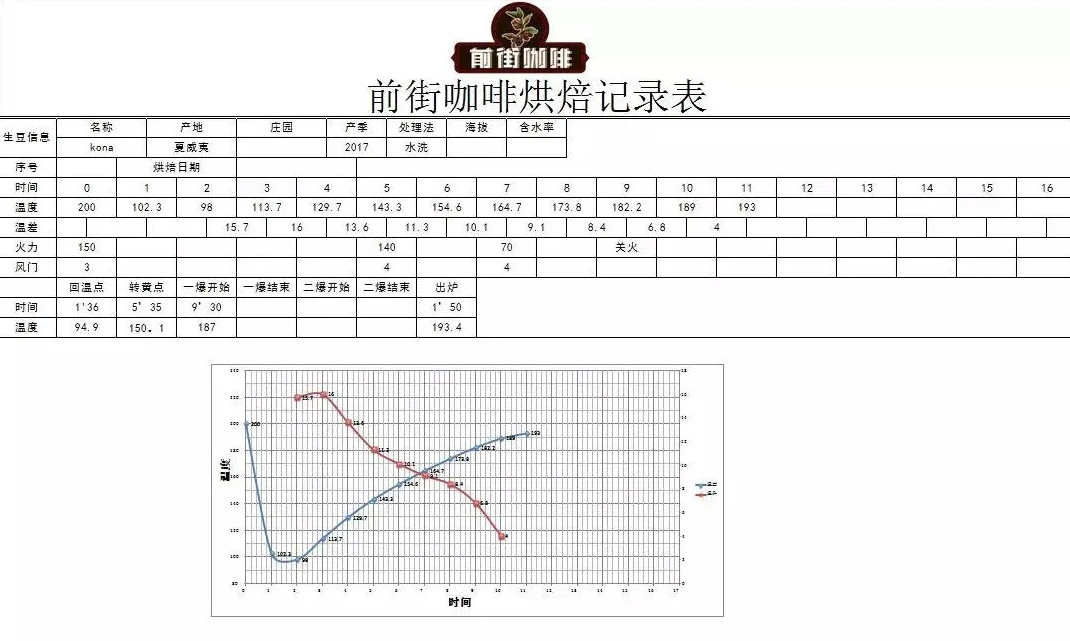
Put the furnace temperature to 200 degrees Celsius, adjust the firepower to 150 degrees after opening the throttle for 1 minute, keep the throttle unchanged, bake to 5 degrees 35 ", the temperature is 150 degrees, the bean surface turns yellow, the smell of grass completely disappears, the dehydration is completed, the firepower is adjusted to 140 degrees, and the throttle is changed to 4.
In the 9th '30th minute, ugly wrinkles and black markings appear on the bean surface, and the smell of toast obviously changes to the smell of coffee, which can be defined as a prelude to an explosion. At this time, listen carefully to the sound of the explosion point, start the explosion at 9: 30 ", lower the firepower to 70 degrees, the throttle should be fully open (adjust the firepower to be very careful, not so small as to be free of bursting sound), turn off the heat at 182 degrees, and put the pot at 193.4 degrees.
Washing and cooking technique
Qianjie coffee tried to use V60 filter cup, siphon pot, Ailo pressure, French pressure pot, KONO five different brewing tools for brewing experiments, to compare the flavor differences.
1 、 Hario V60
Water temperature: 90 ℃
Amount of powder: 15g
Powder / water ratio: 1:15
Degree of grinding: BG-5R (the pass rate of Chinese standard No. 20 screen is 80%)
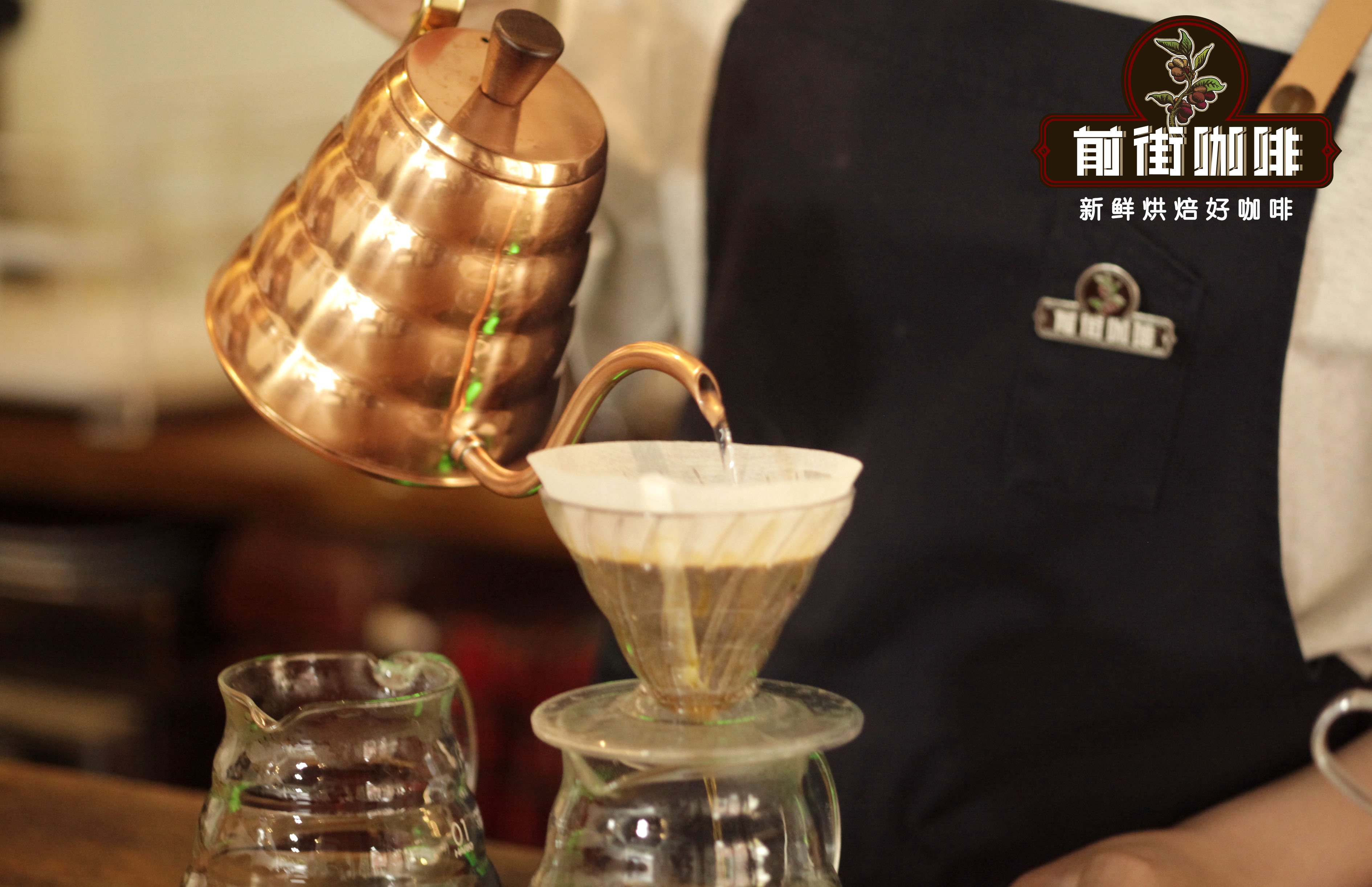
Washing and cooking technique
Steam with 30 grams of water for 30 seconds, small flow circle injection to 125 grams, continue to inject water to 225 grams when the water level is about to be exposed, remove the filter cup when the water level is about to expose the powder bed, (steaming starts timing) the extraction time is 2: 00 ".
Flavor description
Balanced and warm sweet-scented osmanthus honey and elegant fullness not thick taste, brewing coffee emitting mulberry aroma makes people feel sweet and happy, the aftertaste has a soft malt taste, cold down like a cup of mulberry tea.
2. Siphon pot
Powder content: 20g
Powder / water ratio: 1:10
Degree of grinding: BG-6M
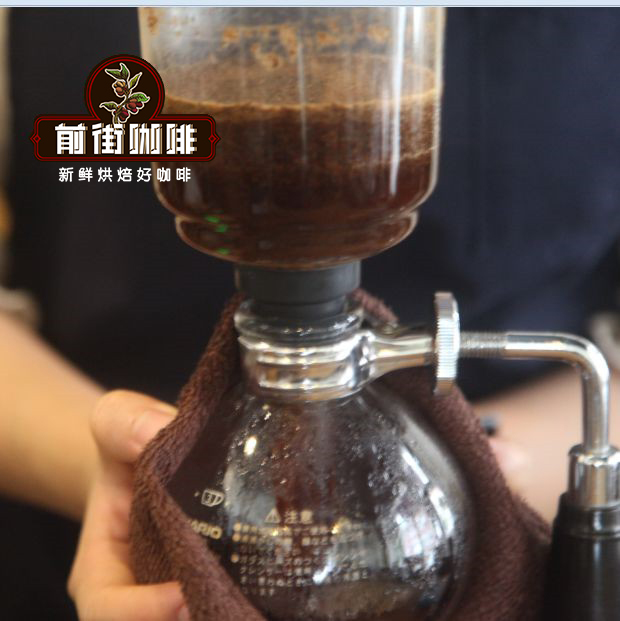
Washing and cooking technique
Put 210g of water in the lower pot and plug the upper pot tightly when the temperature of the lower pot is 90 ℃. When the temperature of the upper pot reaches 90 ℃, pour the coffee powder into full contact with the water. Stir again after 30 seconds to destroy the powder shell, remove the fire source in one minute, wipe the lower pot with a dry cloth to speed up the reflux of the coffee liquid.
Flavor description
Chestnut, caramel, almonds, hazelnuts, plums, toffee, the overall taste is relatively round, obvious aroma.
3. Love music pressure
Water temperature: 88 ℃
Amount of powder: 10 grams
Powder / water ratio: 1:15
Degree of grinding: BG-5R
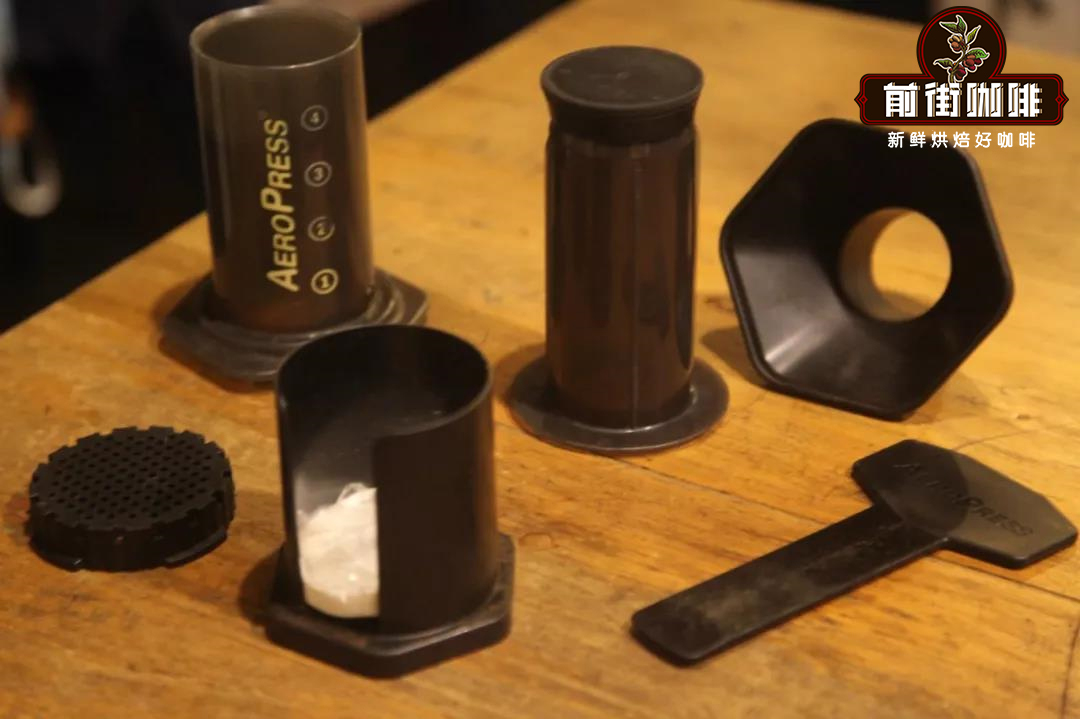
Washing and cooking technique
Cross pressing powder 3 times after direct injection to 147 grams, stirring 3 times in 50 seconds, pressing out at 1: 30 ", the total extraction time is 1: 41".
Flavor description
Sandalwood, herbs, chocolate, plums, peaches, nuts, cream, round taste, rich layers, soft acidity.
4. French pressure kettle
Water temperature: 88 ℃
Powder content: 17g
Powder / water ratio: 1:13
Degree of grinding: BG-5R
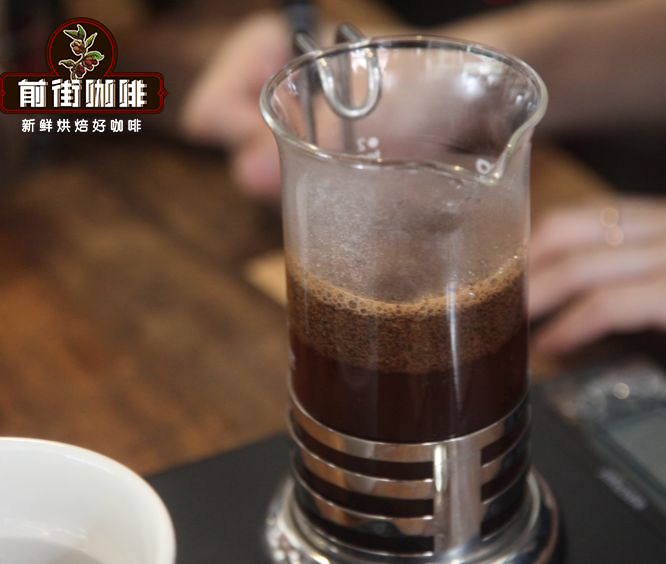
Washing and cooking technique
Directly pour water to 223 grams, stir 5 times, soak for 50 seconds, then stir 4 times, add a pressure bar to press down the coffee grounds in 1 minute, and completely pour out the coffee liquid for 1: 31 ".
Flavor description
Brown sugar, nuts, cream, herbs, dark chocolate, smooth taste with a little grease, high sweetness.
5. KONO filter cup
Water temperature: 88 ℃
Amount of powder: 15g
Powder / water ratio: 1:15
Degree of grinding: BG-6M
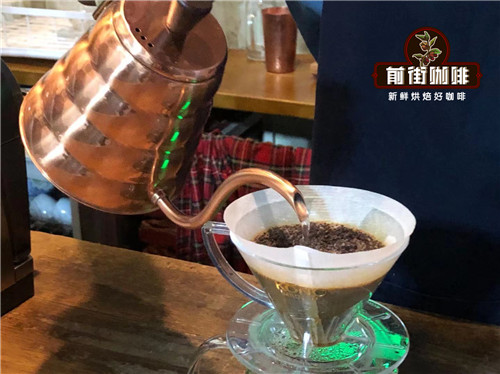
Washing and cooking technique
Steam with 30 grams of water for 30 seconds, small flow circle injection to 125 grams, continue to inject water to 225 grams when the water level is about to be exposed, remove the filter cup when the water level is about to expose the powder bed, (steaming starts timing) the extraction time is 2: 00 ".
Flavor description
Berries, chocolate, cream, spices, fermented aromas, hazelnuts, smooth taste, lively acidity.
Summary
In the process of extracting Hawaiian Kona coffee in different ways, Qianjie coffee found that the flavor levels extracted by V60 and KONO filter cup were rich, and the fruit acid was relatively soft. The three extraction methods of Philharmonic pressure, siphon kettle and French kettle will all contain some oil, so the taste will be more mellow, preferring the flavor of nuts and cream. Qianjie Coffee suggests that if you like rich layers, you can try V60 and KONO. For mellow taste, you can use Philharmonic pressure, siphon pot and French pressure pot.
For more boutique coffee beans, please add private Qianjie coffee on Wechat. WeChat account: kaixinguoguo0925
Important Notice :
前街咖啡 FrontStreet Coffee has moved to new addredd:
FrontStreet Coffee Address: 315,Donghua East Road,GuangZhou
Tel:020 38364473
- Prev
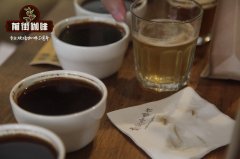
Kona Coffee of Hawaiian Coffee Brand introduces how Hawaiian kona Coffee is graded
Professional coffee knowledge exchange more coffee bean information please follow the coffee workshop (Wechat official account cafe_style) Hawaii coffee is the only top variety produced in 50 states in the United States. As the coffee planting area on the island is very small, the annual output and limited quantity of coffee beans produced in Hawaii are of good quality. Therefore, the price of coffee beans produced in this area will be higher than that of other grown coffee.
- Next

Costa Rican Infinite Manor introduces Costa Rican coffee hand-made Costa Rican coffee flavor
Professional coffee knowledge exchange more coffee bean information Please pay attention to the coffee workshop (Wechat official account cafe_style) Costa Rica is the country where coffee was first introduced to Central America for cultivation, with a long history and a complete coffee organization from production to marketing system. Because it is located in the Central American Gorge, there are many volcanoes in the territory, and it has the natural advantages of sunshine and land, which is affected by both the Pacific Ocean and the Great Pacific Ocean.
Related
- Does Rose Summer choose Blue, Green or Red? Detailed explanation of Rose Summer Coffee plots and Classification in Panamanian Jade Manor
- What is the difference between the origin, producing area, processing plant, cooperative and manor of coffee beans?
- How fine does the espresso powder fit? how to grind the espresso?
- Sca coffee roasting degree color card coffee roasting degree 8 roasting color values what do you mean?
- The practice of lattes: how to make lattes at home
- Introduction to Indonesian Fine Coffee beans-- Java Coffee producing area of Indonesian Arabica Coffee
- How much will the flavor of light and medium roasted rose summer be expressed? What baking level is rose summer suitable for?
- Introduction to the characteristics of washing, sun-drying or wet-planing coffee commonly used in Mantenin, Indonesia
- Price characteristics of Arabica Coffee Bean Starbucks introduction to Manning Coffee Bean Taste producing area Variety Manor
- What is the authentic Yega flavor? What are the flavor characteristics of the really excellent Yejasuffi coffee beans?

